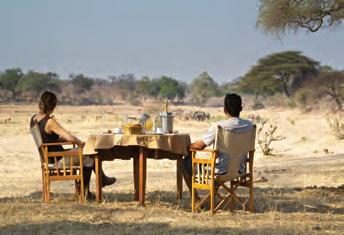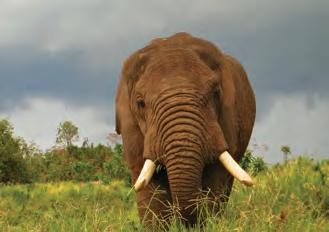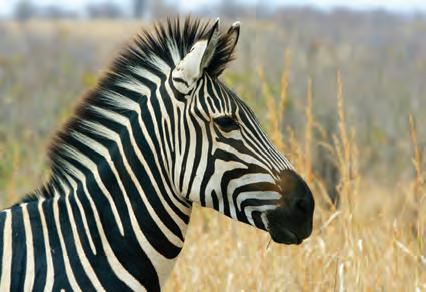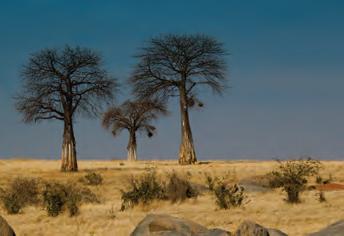
7 minute read
Wild & Untouched Ruaha National Park
RUAHA NATIONAL PARK Second Largest National Park In Africa
For anyone seeking a true African wilderness experience, a visit to Ruaha National Park is essential. One of Tanzania’s wildest parks, Ruaha can only be described as a true, unspoiled, natural wilderness. Because of its distance from any major city, very few tourists visit the park each year. Yet those who do are treated to unsurpassable wilderness and complete isolation. Ruahas’ greatest secret lies in its extraordinary diversity of animals, plants and birds.
Advertisement

The vast majority of the park above the escarpment termed “Miombo Woodland ‘’ is rarely visited by tourists, as it is relatively difficult to reach and known for challenging game viewing and an abundance of tse-tse flies. The scenery in Miombo is quite dramatic, with tall Brachystegia trees forming continuous woodland housing for some specialist species of antelope, such as the magnificent sable, as well as several miombo-specializing birds.
The low -altitude Ruaha Valley is the more developed section of the park, which covers little more than a third of

the park’s total size. The Ruaha Valley has a decent road network for game viewing and a variety of vegetation types, thus offering a diverse game drive experience without the annoyance of tse-tse flies. The Great Ruaha River, which is known as the park’s lifeline, attracts big herds of animals of all shapes and sizes and flows right through the Ruaha Valley. Some of Ruahas’ best features are found in the valley, from massive rocky hills and outcrops to dense, impenetrable bush and open grasslands in the east. The most striking features are numerous serpentine dry “sand rivers”, which crisscross the park and are lined with dense vegetation, where many animals take refuge.
Birding in Ruaha National Park
For birdwatchers, Ruaha’s birdlife is sure to please. There are a recorded 530 different species of birds in the park, including giant herons, saddlebilled storks, white-headed plovers and white-backed night herons. There are six species of both vultures and hornbills, and raptors abound. The crested barbet, an attractive yellowand-black bird whose persistent trilling AUGUST 2020 Dar Life



Located in south-western Tanzania, Ruaha sprawls within and along an ancient arm of the Great Rift Valley, covering a unique transition zone where the eastern and southern species of both fauna and flora meet against a dramatic topographical background. Because of its location on the rift and surrounding geological formations, Ruaha is extremely diverse, with access to several different habitat types.
is a characteristic sound of the southern bush, can also be found in Ruaha alongside central Tanzanian endemics such as the yellow-collared lovebird and ashy starling. The park’s birds make their home among the branches of Ruaha’s 1600 species of trees, which is twice as many as the number of species in the great Selous Game Reserve, although Ruaha is only half the size of Selous.
Wildlife in Ruaha National Park
Only two words can define the wildlife at Ruaha National Park: wild and beautiful. The park holds an incredible array of animals. Among Tanzanian parks, Ruaha possesses one of the highest species counts of large mammals. The park holds an estimated 20,000 elephants alone, and it is not



uncommon in the dry season to see well over 100 elephants in a single drive. Hippos rule the river, and vast quantities of these animals can also be seen sunning themselves along the stunning river sandbanks in the early morning. Massive herds of buffalo, with up to 500 animals plus seen in a single herd, coexist alongside giraffes, zebras, impalas, elands, crocodiles, lions and leopards.
Ruaha is also home to some very rare creatures. Sable antelope can occasionally be found in the Miombo areas as well as in the springs in the western part of the park. Roan antelope are also sometimes seen in the eastern area of the park. Lesser kudus and grant’s gazelle are intermittently spotted at the southernmost point of their geographical



range. Dik-diks abound all over the park, and rarely does a drive return without having glimpsed the noble greater kudu. Ruaha is also home to the second largest population of wild dog in Africa. As the majority of the park’s wild dogs live in the inaccessible wilderness areas of the north, only a few lucky visitors spot them.
Why visit Ruaha National Park?
• Untouched, Pristine Nature:
Tanzania, which means that the park’s wildlife has hardly been altered by human intervention. • Personalized Wildlife
Watching: Because Ruaha is expanding in size yearly, the chances of bumping into other vehicles that can startle an animal you may be already watching are limited. Lots to Discover: In areas where park authorities have formal tracks, there are no access restrictions, which allows visitors a great deal of freedom to explore undiscovered territory. Currently, Tanzanian park authorities are adding more routes while carefully monitoring the ecological impact, thus ascertaining that the wildlife remains as undisturbed as possible. There are plans to add up to 1500 kilometers of road networks. Go by Foot: Ruaha is one of the few national parks in Tanzania where walking safari is permitted when accompanied by an armed ranger. This liberty gives nature enthusiasts an opportunity to receive an up-close and personal



experience with wildlife in dense places where safari vehicles cannot penetrate.
Getting to Ruaha National Park
There are two ways guests can reach Ruaha National Park. One is by road, through Iringa from Dar es Salaam via Mikumi, or from Arusha via Dodoma. Ruaha is also accessible by plane. Scheduled charter flights are available from Dar es Salaam, Selous, Serengeti, Arusha, Iringa and Mbeya through companies such as Safari Air Link, Flight Link and Coastal Aviation.
When to go
To see predators and large mammals, dry season (mid-May to December); to see birds, lush scenery and wildflowers, wet season (January to April). The male greater kudu is most


visible in June, which is the breeding season.
Accommodation
Asanja Ruaha: Just off the Great Ruaha River nestles Asanja Ruaha, amongst Miombo pristine forest and the magnificent ancient Baobabs Ruaha is famous for. With eight luxury guest suites, designed by renown safari camp architect Neil Rocher, you know no expense has been spared to ensure your utmost comfort and privacy. Neil’s attention to detail shines throughout the camp. Each tented suite is 140 sq.metres with its own private
58

verandah, overlooking the Great Ruaha River and plunge pool for you to cool off after a game activity or a Pop up Spa to pamper yourself. All suites have ensuite bathrooms with flush toilets and hot showers.
Ruaha River Lodge: occupies a unique and privileged position, set around a series of rocky kopjes in a bend of the Great Ruaha River. The lodge off ers 24 stone chalets stretching along the river bank that offers guests the opportunity to have their own riverside cottage designed to blend seamlessly into the surroundings. The lodge extends


Picture Courtesy of Moiz Husein & TTB
along the rocky shores of the great Ruaha River, affording views up and down the river. Game animals are drawn to the river from the neighbouring hills, and guests can see great wildlife dramas unfold from the comfort and protection of their self-contained natural stone and thatch ‘cottage’.
For the more discerning safari lover who is looking for an ‘off the beaten track’ pure wilderness experience, a visit to Ruaha to view its large beasts, stunning vistas, numerous baobabs and unique birds and animals must not be missed!











